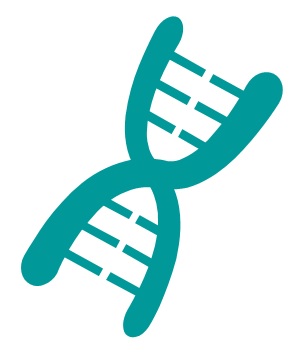Biotin-PADRE peptide – AKFVAAWTLKAAA
Biotin-PADRE peptide is the biotinylated version of PADRE peptide – AKFVAAWTLKAAA which is a universal synthetic peptide binding (MHC)-II receptors that activates antigen specific CD4+ T-cells.
Universal Major Histocompatibility Complex (MHC) epitope for CD4+ T-cell recruitment and activation
Pan DR-binding epitope (PADRE) is a universal synthetic peptide binding (MHC)-II receptors,of which Human Leukocyte Antigen (HLA)-DR receptors,present on specific immune cells. This epitope activates antigen specific CD4+ T-cells,while initiating innate immune response (inflammatory cascade). This feature describes PADRE’s ability to act as a Toll-like receptor (TLR) agonist which explains its use as adjuvant in many immunotherapeutic vaccines. In addition,PADRE was also reported as an alternative to more complex carriers,such as KLH/BSA or OVA,for prophylaxis and therapeutic vaccines to increase vaccines’ effectiveness and enable large-scale production. Thanks to its high affinity for 15 of the 16 most common HLA-DR types,PADRE has been presented as a universal approach to control anti-tumor immunity and it is currently investigated for the treatment of toxoplasmosis in people with HLA-A*03 type. Moreover,its ability to bind HLA-DR receptors,despite their extreme polymorphism in the human population,makes it a tool of choice to study autoreactive T-cell responses.
SB-PEPTIDE offers the scrambled version,as well as the restricted version of this PADRE peptide. See « PADRE scrambled (AAATLWKAAKFVA) » and « Restricted PADRE peptide – ak(Cha)VAAWTLKAAa-Ahx-C » sections to know the prices.
Technical specification
 |
Sequence : Biotin-AKFVAAWTLKAAA – Purity : > 95% |
 |
MW : 1573 ,90 g/mol (C75H116N18O17S) |
 |
For research use |
 |
Counter-Ion : TFA Salts (see option TFA removal) |
 |
Delivery format : Freeze dried in polypropylene 2 mL microtubes |
 |
Other names : Biotin-Pan HLA DR-binding epitope |
 |
Peptide Solubility Guideline |
 |
Bulk peptide quantities available |
Price
| Product catalog | Size | Price € HT | Price $ USD |
| SB183-1MG | 1 mg | 198 | 248 |
SB-PEPTIDE offers a wide range of antigens on catalog. Browse our antigen catalog to find out more.
SB-PEPTIDE offers non-conformational epitope mapping service. SB-PEPTIDE can synthesize the antigenic protein as a library of overlapped peptides (usually 15aa, 5aa overlap) and perform ELISA to determine the epitope.
References
PLoS ONE. 2015 Nov 10; 10(11):e0142563. doi: https://doi.org/10.1371/journal.pone.0142563
Improving Multi-Epitope Long Peptide Vaccine Potency by Using a Strategy that Enhances CD4+ T Help in BALB/c Mice
Peptide-based vaccines are attractive approaches for cancer immunotherapy; but the success of these vaccines in clinical trials have been limited. Our goal is to improve immune responses and anti-tumor effects against a synthetic, multi-epitope, long peptide from rat Her2/neu (rHer2/neu) using the help of CD4+ T cells and appropriate adjuvant in a mouse tumor model. Female BALB/c mice were vaccinated with P5+435 multi-epitope long peptide that presents epitopes for cytotoxic T lymphocytes (CTL) in combination with a universal Pan DR epitope (PADRE) or CpG-oligodeoxynucleotides (CpG-ODNs) as a Toll-like receptor agonist adjuvant. The results show that vaccination with the multi-epitope long peptide in combination with the PADRE peptide and CpG-ODN induced expansion of subpopulations of CD4+ and CD8+ cells producing IFN-γ, the average tumor size in the vaccinated mice was less than that of the other groups, and tumor growth was inhibited in 40% of the mice in the vaccinated group. The mean survival time was 82.6 ± 1.25 days in mice vaccinated with P5+435 + CpG+ PADRE. Our results demonstrate that inclusion of PADRE and CpG with the peptide vaccine enhanced significant tumor specific-immune responses in vaccinated mice.
PLoS ONE. 2014 Dec 22; 9(12):e115711. doi: https://doi.org/10.1371/journal.pone.0115711
Cancer immunotherapy employing an innovative strategy to enhance CD4+ T cell help in the tumor microenvironment
Chemotherapy and/or radiation therapy are widely used as cancer treatments, but the antitumor effects they produce can be enhanced when combined with immunotherapies. Chemotherapy kills tumor cells, but it also releases tumor antigen and allows the cross-presentation of the tumor antigen to trigger antigen-specific cell-mediated immune responses. Promoting CD4+ T helper cell immune responses can be used to enhance the cross-presentation of the tumor antigen following chemotherapy. The pan HLA-DR binding epitope (PADRE peptide) is capable of generating antigen-specific CD4+ T cells that bind various MHC class II molecules with high affinity and has been widely used in conjunction with vaccines to improve their potency by enhancing CD4+ T cell responses. Here, we investigated whether intratumoral injection of PADRE and the adjuvant CpG into HPV16 E7-expressing TC-1 tumors following cisplatin chemotherapy could lead to potent antitumor effects and antigen-specific cell-mediated immune responses. We observed that treatment with all three agents produced the most potent antitumor effects compared to pairwise combinations. Moreover, treatment with cisplatin, CpG and PADRE was able to control tumors at a distant site, indicating that our approach is able to induce cross-presentation of the tumor antigen. Treatment with cisplatin, CpG and PADRE also enhanced the generation of PADRE-specific CD4+ T cells and E7-specific CD8+ T cells and decreased the number of MDSCs in tumor loci. The treatment regimen presented here represents a universal approach to cancer control.
J. Immunol. 2000 Feb 01; 164 (3): 1625–1633. doi: https://doi.org/10.4049/jimmunol.164.3.1625
Linear PADRE T Helper Epitope and Carbohydrate B Cell Epitope Conjugates Induce Specific High Titer IgG Antibody Responses
Linear carbohydrate-peptide constructs based on the 13 amino acid nonnatural pan DR epitope (PADRE) and carbohydrate B cell epitopes are demonstrated to be potent immunogens. These data support our belief that PADRE should be considered as an alternative to more complex carriers for use in prophylaxis and therapeutic vaccines. Two model carbohydrate-PADRE glycoconjugates were used to demonstrate that PADRE could effectively provide T cell help for carbohydrate-specific Ab responses. Conjugates of PADRE covalently linked to the human milk oligosaccharide, lacto-N-fucopentose II or a dodecasaccharide derived from Salmonella typhimurium O-Ag induced high titer IgG Ab responses in mice, which were comparable to glycoconjugates employing human serum albumin (HSA) as the carrier protein. Different adjuvants, in combination with PADRE conjugates, allowed for the modulation of the isotype profile with alum supporting an IgG1 profile; QS-21 an IgG2a, 2b profile, while an alum/QS-21 mixture generated a balanced IgG1/IgG2b isotype profile. As defined by binding to synthetic glycoconjugates, dodecasaccharide-specific Abs exhibited fine specificity similar to protective polyclonal Ab responses previously reported for dodecasaccharide-protein conjugates. The same Abs bound to intact S. typhimurium cells, suggesting that biologically relevant specificities were produced. The affinity of the dodecasaccharide-specific Abs was further shown to be comparable to that of a well-characterized, high affinity monoclonal anti-carbohydrate Ab recognizing the same epitope.
